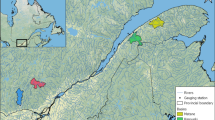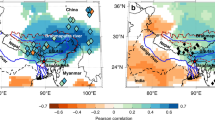Abstract
The Chobe River, characterized by an unusual flood pulsing regime and shared between Botswana and Namibia, lies at the heart of the world’s largest transfrontier conservation area (the Kavango–Zambezi Transfrontier Conservation Area). Significant ecological changes and vegetation conversions are occurring along its floodplains. Various scenarios for agricultural and urban water use are currently being proposed by the government of Botswana. However, the understanding of the river’s annual flow regime and timing of the relative contributions of water from three different sources is relatively poor. In light of past and future climate change and variability, this means that allocating water between ecological flows and economic and domestic uses will become increasingly challenging. We reconstruct the inundation history in this basin to help ease this challenge. This paper presents a spatiotemporal approach to estimate the contribution of water from various sources and the magnitude of changes in the flooding extent in the basin between 1985 and 2010. We used time series analysis of bimonthly NOAA AVHRR and NASA MODIS data and climatologic and hydrologic records to determine the flooding timing and extent. The results indicate that between 12 and 62 % of the basin is flooded on an annual basis and that the spatial extent of the flooding varies throughout the year as a function of the timing of peak discharge in two larger basins. A 30-year trend analysis indicates a consistent decline in the average monthly flooded area in the basin. The results may prove useful in future water utilization feasibility studies, in determining measures for protecting ecological flows and levels, and in ecosystem dynamics studies in the context of current and future climate change and variability.















Similar content being viewed by others
References
All, J. D. (2006). Colorado River floods, droughts and shrimp fishing in the Upper Gulf of California, Mexico. Environmental Management, 37, 111–125.
All, J. D., & Yool, S. (2004). Indexing endangered species risk in the Colorado River Delta, Mexico using AVHRR NDVI time series data. Geocarto International, 19(4), 5–13.
Alsdorf, D. E., & Lettenmeier, D. P. (2003). Tracking fresh water from space. Science, 301, 1491–1494.
Appleton, C. C., Ellery, W. N., Byskov, J., & Mogkweetsinyana, S. S. (2008). Epidemic transmission of intestinal schistosomiasis in the seasonal part of the Okavango Delta, Botswana. Annals of Tropical Medicine and Parasitology, 102(7), 611–623.
Birkett, C. M. (2000). Synergistic remote sensing of Lake Chad: variability of basin inundation. Remote Sensing of Environment, 72, 218–236.
Boko, M., I. Niang, A. Nyong, C. Vogel, A. Githeko, M. Medany, B. Osman-Elasha, R. Tabo and P. Yanda. (2007). Africa: climate change 2007: impacts, adaptation and vulnerability. In M.L. Parry, O.F. Canziani, J.P. Palutikof, P.J. van der Linden and C.E. Hanson (Eds.), Contribution of Working Group II to the Fourth Assessment Report of the Intergovernmental Panel on Climate Change (pp. 433–467). Cambridge UK: Cambridge University Press.
Boulain, N., Cappelaere, B., Seguis, L., Gignous, J., & Peugeout, C. (2006). Hydrologic and land use impacts on vegetation growth at the watershed scale in a semi-arid environment. Regional Environmental Change, 6, 147–156.
Brown, M. E., Pinzon, J. E., Didan, K., Morisette, J. T., & Tucker, C. J. (2006). Evaluation of the consistency of long-term NDVI time series derived from AVHHR, SPOT Vegetation, SeaWiFS, MODIS and LandSat ETM+ Sensors. IEEE Transactions on Geoscience and Remote Sensing, 44, 1787–1793.
Bryant, R. G. (1999). Application of AVHRR to monitor a climatically sensitive playa: case study, Chott el Djerid, Southern Tunisia. Earth Surface Processes and Landforms, 24, 283–302.
Bryant, R. G. (2003). Monitoring hydrological controls on dust emissions: preliminary observations from Etosha Pan, Namibia. The Geographical Journal, 169(2), 131–141.
Cassidy, L. (2007). Mapping the area burned in the wetlands of the Okavango panhandle using a hierarchical classification approach. Wetlands Ecology and Management, 15, 253–268.
Center for the Study of Institutions, Population and Environmental Change. (2005). CIPEC’s methodological contributions. CIPEC, Bloomington, Indiana. Retrieved from http://www.cipec.org/research/methods. Accessed 15 May 2007.
Chipman, J. W., & Lillesand, T. M. (2007). Satellite-based assessment of the dynamics of new lakes in southern Egypt. International Journal of Remote Sensing, 28(19), 4365–4379.
Department of Wildlife and National Parks (DWNP) Botswana. (2009). Aerial survey on wildlife populations of Botswana. Botswana: DWNP Gaborone.
Domenikiotis, C., Loukas, A., & Dalezios, N. R. (2003). The use of NOAA/AVHRR satellite data for monitoring and assessment of forest fires and floods. Natural Hazards and Earth System Sciences, 3, 115–128.
European Space Agency. (2009). ENVISAT Altimeter. Retrieved 4 February 2009 from http://envisat.esa.int/earth/www/object/index.cfm?fobjectid=6995.
Gaughan, A. E., & Waylen, P. R. (2012). Spatial and temporal precipitation variability in the Okavango–Kwando–Zambezi catchment, Southern Africa. Journal of Arid Environments, 82, 19–30.
Gumbricht, T., McCarthy, T. S., & Merry, C. L. (2001). The topography of the Okavango Delta, Botswana, and its tectonic and sedimentological implications. South African Journal of Geology, 104, 243–264.
Huete, A. R., Liu, H. Q., Batchily, K., & van Leeuwen, W. J. D. (1999). A comparison of vegetation indices over a global set of TM images for EOS-MODIS. Remote Sensing of Environment, 59, 440–451.
Huffman, G. J., Adler, R. F., et al. (1997). The Global Precipitation Climatology Project (GPCP) combined precipitation dataset. Bulletin of the American Meteorological Society, 78(1), 5–20.
Jain, S. K., Saraf, A. K., Goswami, A., & Ahmad, T. (2006). Flood inundation mapping using NOAA AVHHR data. Water Resources Management, 20, 949–959.
Jia, Z., & Luo, W. (2009). A modified climate diagram displaying net water requirements of wetlands in arid and semi-arid regions. Agricultural Water Management, 96, 1339–1343.
Justice, C. O., Vermote, E., Townshend, J. R. G., Defries, R., Roy, D. P., Hall, D. K., et al. (1998). The Moderate Resolution Imaging Spectroradiometer (MODIS): land remote sensing for global change research. IEEE Transactions on Geoscience and Remote Sensing, 36(4), 1228–1249.
Kummerow, C., Simpson, J., Thiele, O., et al. (2000). The status of the Tropical Rainfall Measuring Mission (TRMM) after two years in orbit. Journal of Applied Meteorology, 39, 1965–1982.
Liu, H. Q., & Huete, A. R. (1995). A feedback based modification of the NDVI to minimize canopy background and atmospheric noise. IEEE Transactions on Geoscience and Remote Sensing, 33, 457–465.
McCarthy, J. M., Gumbricht, T., McCarthy, T., Frost, P., Wessels, K., & Seidel, F. (2003). Flooding patterns of the Okavango Wetland in Botswana between 1972 and 2000. Ambio, 32(7), 453–457.
Mildrexler, D. J., Zhao, M., & Running, S. W. (2009). Testing a MODIS Global Disturbance Index across North America. Remote Sensing of Environment, 113, 2103–2117.
Mosugelo, D., Moe, S. R., Ringrose, S., & Nelleman, C. (2002). Vegetation changes during a 36-year period in northern Chobe National Park, Botswana. African Journal of Ecology, 40(3), 232–240.
Nicholson, S. E. (2001). Climatic and environmental change in Africa during the last two centuries. Climate Research, 17, 123–144.
Nicholson, S. E., Some, B., & Kone, B. (2000). An analysis of recent rainfall conditions in West Africa, including the rainy seasons of the 1997 El Nino and 1998 La Nina Years. Journal of Climate, 13, 2628–2640.
Nicholson, B., Some, J., McCollum, E., Nelkin, D., Klotter, Y., Berte, B. M., et al. (2003). Validation of TRMM and other rainfall estimates with a high-density gauge dataset for West Africa. Part I: Validation of GPCC rainfall product and pre-TRMM satellite and blended products. Journal of Applied Meteorology, 42, 1337–1354.
Peters, D. P. C., & Havstad, K. M. (2006). Nonlinear dynamics in arid and semi-arid systems: interactions among drivers and processes across scales. Journal of Arid Environments, 65, 196–206.
Prigent, C., Papa, F., Aires, F., Rossow, W. B., & Matthews, E. (2007). Global inundation dynamics inferred from multiple satellite observations, 1993–2000. Journal of Geophysical Research, 112, D12107.
Ringrose, S., VanderPost, C., Mathson, W., Wolski, P., Huntsman-Mapila, P., Murray-Hudson, M., et al. (2007). Indicators of desiccation-driven change in the distal Okavango Delta, Botswana. Journal of Arid Environments, 68(1), 88–112.
Rogers, A. S., & Kearney, M. S. (2004). Reducing signature variability in unmixing coastal marsh Thematic Mapper scenes using spectral indices. International Journal of Remote Sensing, 20, 2317–2335.
Rutina, L. P., Moe, S. R., & Swenson, J. E. (2005). Elephant Loxodonta africana driven woodland conversion to shrubland improves dry-season browse availability for impalas Aepyceros melampus. Wildlife Biology, 11, 207–213.
Sakamoto, T., Van Nguyen, N., Kotera, A., Ohno, H., Ishitsuka, N., & Yokozawa, M. (2007). Detecting temporal changes in the extent of annual flooding within the Cambodia and the Vietnamese Mekong Delta from MODIS time-series imagery. Remote Sensing of Environment, 109, 295–313.
Sakamoto, T., Phung, V. C., et al. (2009). Agro-ecological interpretation of rice cropping systems in flood-prone areas using MODIS imagery. Photogrammetric Engineering and Remote Sensing, 75(4), 413–424.
Sankaran, M., Hanan, N. P., Scholes, R. J., Ratnam, J., Augustine, D. J., Cade, B. S., et al. (2005). Determinants of woody cover in African savanna. Nature, 438(8), 846–849.
Skarpe, C., Aarrestad, P. A., Andreassen, H. P., Dhillion, S. S., Dimakatso, T., du Toit, J. T., et al. (2004). The return of the giants: ecological effects of an increasing elephant population. Ambio, 33, 276–282.
Smith, L. P. (1997). Satellite remote sensing of river inundation area, stage, and discharge: a review. Hydrological Processes, 11, 1427–1439.
Snyder, K. A., & Tartowski, S. L. (2006). Multi-scale temporal variation in water availability: implications for vegetation dynamics in arid and semi-arid ecosystems. Journal of Arid Environments, 65, 219–234.
Teillet, P. M., Staenz, K., & William, D. J. (1997). Effects of spectral, spatial, and radiometric characteristics on remote sensing vegetation indices of forested regions. Remote Sensing of Environment, 61(1), 139–149.
Turton, A. R. (1999). Water and state sovereignty: the hydropolitical challenge for states in arid regions. MEWREW Occasional Paper No. 5, Water Issues Study Group.
Wang, F., & D’Sa, E. (2010). Potential of MODIS EVI in identifying hurricane disturbance to coastal vegetation in the northern Gulf of Mexico. Remote Sensing, 2, 1–18.
Wessels, K. J., Prince, S. D., Frost, P. E., & van Zyl, D. (2004). Assessing the effects of human-induced land degradation in the former homelands of northern South Africa with a 1 km AVHRR NDVI time-series. Remote Sensing of Environment, 91, 47–67.
Westbrooke, M. E., & Florentine, S. K. (2005). Rainfall-driven episodic flood events: are they a major factor in moulding New South Wales arid land vegetation patterns? Australian Geographer, 36(2), 171–181.
Westbrooke, M. E., Florentine, S. K., & Milberg, P. (2005). Arid land vegetation dynamics after a rare flooding event: influence of fire and grazing. Journal of Arid Environments, 61(2), 249–260.
Wolter, K. (1987). The Southern Oscillation in surface circulation and climate over the tropical Atlantic, Eastern Pacific, and Indian Oceans as captured by cluster analysis. J Climate Appl Meteor, 26, 540–558.
Wolter, K., & Timlin, M. S. (1998). Measuring the strength of ENSO events—how does 1997/98 rank? Weather, 53, 315–324.
Yan, Y. E., Ouyang, Z. T., Guo, H. Q., Jin, S. S., & Zhao, B. (2010). Detecting the spatio-temporal changes of tidal flood in estuarine wetlands by using MODIS time series data. Journal of Hydrology, 384, 156–163.
Acknowledgments
This research was primarily funded by a National Science Foundation Dissertation Improvement Grant (no. 0824720) and also through continued support from a University of Florida National Science Foundation Interdisciplinary Graduate Education and Research Traineeship (IGERT) grant (no. 0504422). We would particularly like to thank Dr. Jane Southworth (University of Florida), Dr. Mark Brown (University of Florida), Dr. John All (Western Kentucky University), Dr. Susan Ringrose (HOORC, Botswana), and Dr. Mike Murray-Hudson (HOORC, Botswana) for discussions which helped improve the paper. We want to thank Mr. Dawie van Zyl (CRID, South Africa) for providing the AVHRR NDVI data, Dr. John Mendelsohnn and Mr. Guido van Langenhove (Department of Water Resources, Windhoek, Namibia) for providing the Zambezi and Kwando discharge data.
Author information
Authors and Affiliations
Corresponding author
Rights and permissions
About this article
Cite this article
Pricope, N.G. Variable-source flood pulsing in a semi-arid transboundary watershed: the Chobe River, Botswana and Namibia. Environ Monit Assess 185, 1883–1906 (2013). https://doi.org/10.1007/s10661-012-2675-0
Received:
Accepted:
Published:
Issue Date:
DOI: https://doi.org/10.1007/s10661-012-2675-0




